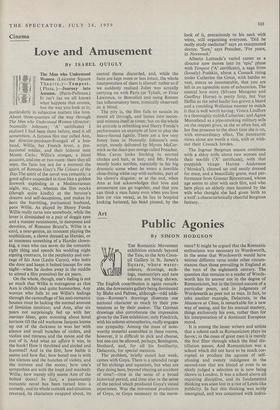Art
Public Agonies
By SIMON HODGSON
THE Romantic Movement exhibition extends beyond the Tate, to the Arts Coun- cil Gallery in St. James's Square, where water- colours, drawings, etch- ings, manuscripts and rare editions are being shown. The English contribution is again remark- able, the downstairs gallery being dominated by Blake and Palmer, although—odd add/. tion—Romney's drawings illustrate our national character as much by their pre- tensions as by their pudeur. The German drawings also corroborate the impression given by the Tate exhibition; only Friedrich, with his solemn atmospherics, really engages our sympathy. Among the mass of note- worthy material assembled in these rooms, however, it is difficult to pick and choose, but one can be allowed, perhaps, Bonington, Stothard, and, for all his familiarity, Delacroix, for special mention.
The problem, briefly stated last week, comes with Goya. There is a splendid range of his etchings and aquatints, but what are they doing here, beyond obeying an accident of time?—time in the sense of a broad historical period, and time also in the sense of the period which produced Goya's visual experience. Was the movement productive of Goya, or Goya necessary to the move- ment? It might be argued that the Romantic enthusiasm was necessary to Wordsworth, in the sense that Wordsworth would have written different verse under other circum- stances than those prevailing in England at the turn of the eighteenth century. The question that remains to a reader of Words- worth has its answer not in the degree of Romanticism, but in the limited success of a particular poem, and in judgments of Wordsworth as poet not as man. In fact, to take another example, Delacroix, in the Massacre at Chios, is remarkable for a new way of seeing, and for his manual mastery, things exclusively his own, rather than for his interpretation of a dominant European mood.
It is among the lesser writers and artists that a school such as Romanticism plays its havoc; in the cases of great men it is merely the first filter through which the final dis- tillation passes. And Romanticism was a school which did not have to be much cor- rupted to produce the agonies of self- abusing and sweaty indulgence in the second-rate that are hinted at even in so nicely judged a selection as is now being shown in London. It was a school above all requiring discipline, and its fundamental thinking was soon lost in a riot of Lewis-like publicity. In fact this thinking was nobly unoriginal, and was concerned with indivi- dual liberty—in behaviour, expression, and thought. Perhaps it was rather less than noble, for it postulated, as Rousseau the greatest and the worst of them said, that man has, of his nature, the right to freedom. Neither then nor now has the negative corollary been posed, that man, always inclining away from freedom, has the right to be free as, simply, no one has yet satis- factorily demonstrated that he ought to be in chains. The charm of the Romantic Movement was that it seemed to dare the world to provide this proof. But it is another thing to suppose that the splendours of Delacroix, and the warm glimpses of nature, both seen and imagined, by English artists relied on anything more than traditional disciplines extended by new enthusiasms (or fashions if you prefer).
Without these disciplines, art would be wholly anarchic (this is not to suggest that a studio Napoleon was needed to systematise and canalise early nineteenth-century paint- ing); the means by which an artist can communicate his especial vision, or can communicate simple pleasure, is not, pace Mr. Berger, through, or in terms of, our own contemporary preoccupations, but through a tradition shared and common to him and to us, extended in the artist's per- sonal direction, but comprehensible by its universality; all this despite local, European or Oriental, habits of approach. The virtue, in fact, is in the object. It is because they forgot this that the ruck of Romantic artists are so abominably dispiriting when com- pared with the ruck of earlier fashions in subject matter and pictorial manners. They are meaningless, in fact, as a group, because they forgot their original challenge in their competitive and exhibitionist ardour. Apart from the great artists, and the genre painters, the early nineteenth century produced only third-rate works, and for so wide a gulf to be fixed between the masters and the com- mon practitioners was surely a disaster from which all artistic activity is still suffering, not least in the lack of mutual discipline, experiment, and advance.
It is odd that the age of shared responsi- bility and corporate thinking should also be that in which no central school of pictorial thought exists to train and guide painters— to train them that is, not to conform, but to a level where personal idiosyncrasy will re- main comprehensible inside known disci- plines. At the Leicester Galleries' summer miscellany may be seen, among many pleasant things, a fine work by Laurence Atkinson, who was a member of the last school of painting worth the name in Europe, the Cubists.







































 Previous page
Previous page